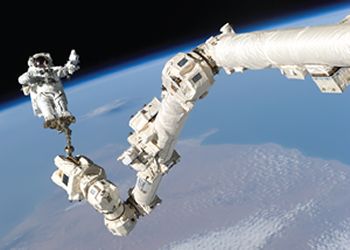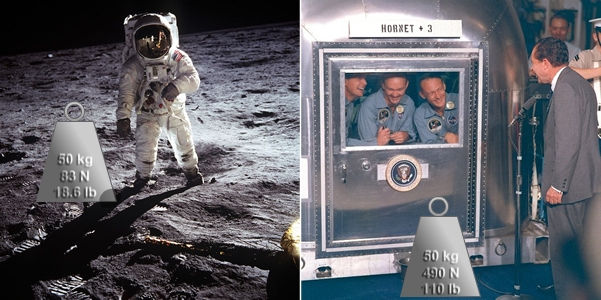Chapter 4. Newton's Laws of Motion
4.1 Introduction

Author: Kristin Miller
Editor: Grace L. Deming, University Of Maryland

The goals of this module: After completing this exercise, you should be able to:
- Describe Newton's three laws of motion.
- Explain in basic terms what each law states.
- Describe the difference between mass and weight.
- Understand how force, mass and acceleration are interrelated.
- Begin to understand how Newton’s laws of motion led him to explain why the planets orbit the Sun.
In this module you will explore:
- Newton's three laws of motion and what they tell us.
- What happens to an object moving in a circular orbit when you remove the external force.
- The effect of exerting a force on a mass and seeing how it accelerates.
- How the forces between two objects relate.
Why you are doing it: By studying Newton's laws of motion, you will not only get a feeling for why objects move and accelerate as they do, but you will also begin to see how Newton eventually used his laws of motion to develop his universal law of gravity.
4.2 Background

At the beginning of the seventeenth century, Johannes Kepler was able to explain how the planets orbited around the Sun, but he was unable to explain why. It wasn't until the late seventeenth century, when Isaac Newton came along, that we would get the answer to that question.
While Newton would eventually go on to explain that it is a gravitational force between the Sun and the planets which keeps them in orbit around the Sun, he first started out by explaining what have become known as Newton's laws of motion. These three laws dictate how objects move and accelerate, based on the forces they experience. It is based on these three laws that Newton discovered the universal law of gravity. Therefore, by first understanding these three laws, we will develop a better appreciation of Newton's law of gravity.
4.3 Newton's First Law
Newton's first law of motion is:
An object remains at rest, or moves in a straight line at a constant speed, unless acted upon by a net outside force.
In other words, an object is going to keep doing what it is doing until you do something to it. The computer on your desk is doing an excellent job of demonstrating Newton's first law of motion. Right now it is sitting still. As long as you don’t do anything to it, it will continue to sit still. It is not about to spontaneously fall off of your desk, throw itself against the wall, or slide down the corridor.
A hockey puck is also a good example of Newton's first law. A hockey player hits the hockey puck with his stick. Due to the low friction between the puck and the ice, the puck will continue to move in a straight line motion, neither speeding up nor slowing down, until it either hits a wall, or another player hits it.
Another example of Newton's first law of motion is demonstrated in the animation on the right. A person is whirling a ball as it is attached to a string. According to Newton's first law, the ball should be moving in a straight line motion, but it is not, because an outside force is acting upon it. What is that force? It is the force of the string pulling on the ball towards the center of the circle. The ball has an initial straight-line motion, but the force of the string pulls it out of that motion.
Click on the "Change View" button to see an overhead view of"the rotating ball. See how the ball is moving in a circular motion about the person's palm. Next, click on "Release" to see what happens when the person lets go of the string.
Question 4.1
XeOEw5K8cXT7hckauTUJVtMqtbzpnlIdyB6hyuJ7sY6SDuQJMfbxjNP5JYECC5+4PB3uJPQLrBNN7Dxi8zu2P9oDo7vaFH9pZkp9qqbLegC0zhQMcUsD0OACc3wxBZdzJll+avWOdj5TZcmjqT9rleoDiesNf37kzeTe9FstipERTVZAdGHtdYEY7iAkn7fTj0Abw7EB0wviL/8PYPi6Clc9jIP0UY4UasqeYyUccIH9khDPSvOkUPBsaLg1GXlf2CiCsL9DxmdIgUYsv2w9a9JBvPdzyeJzIdpRJ9fMB+C0ek02zgTR1ImX2nuuQVLpCXRGs/2Lq/G3bb4WMkXNlfbUnrcAtd0rCsYhArj0Rh9qe7ICnbg/NNiuFgpA6j3Xw63sB1zF9PB3u5IADVQ2CEQ0YJ5EjWruVQuHMSJSiUXRmvcUxG1NlqG+g7KIOFW7P3X+Ej5l+ffNQ+qQv49ScgRSHd33kk/a/be+4mP+rHbnY5NQTDW97UOXXlk=4.4 Inertia, Mass and Weight
The property of an object to resist changes in its state of motion (either from a state of rest or its current velocity or direction of motion) is its inertia. The inertia of an object depends on its mass. The mass of an object is simply a measurement of how much "stuff" it is made of (all of the electrons, protons, neutrons,etc. that go into making an object). The mass of an object does not depend on its location. It is a property of an object that will not change as it moves from one place to another.
Mass is different than weight. Weight is a force. Specifically, we measure weight as the force of Earth pulling down on us. We can register our weight by stepping on a scale. As we do so, the Earth pulls down on us, causing us to compress springs in the scale. The more we compress them, the more we weigh.Weight depends on mass (the more massive the object, the more it weighs), but it also depends on other properties as well.

The figure above shows two objects with equal mass of 50 kg, one sitting on the surface of the Earth and one on the surface of the Moon. Although the masses are identical, their weights are not. The International Scientific unit of weight is called a Newton, but the more familiar English units of pounds are also given.
Question Sequence
Question 4.2
KCSykYdrQzwLaeKVsk+XlgSy5rOPfyfV5z9X/PKDOCJ0CJl+P7iNb7HVgh1++axanSdX1IZvvW2tDIYPWpKxWx9Px7oG41Wy3dckbxMhLxdbv//HzdkHO4mOIhGUKq27oy7q38JZXS8y1au1UZQk11Ej1M+myqbpaBaliFogN8htFwO0FB8WtBRbzlVroM60rI08uregs+nFVNqbdYfsng0txaQPTpniLqRVdZJPrNG7YObV88NWfswqbc03A/OQSM23tLIlrbXHhcH6gReSowoucdXgHQ8CWuXdXrDJER2sfHB792MZCBq0CZe1o7DEh5b5vdC10YP9B6Znku4Vb+idVb79wRJHzNghStUwEVcL1l7uGRjSWgbDiB9q6t/OkclEm73fnzRhEUJSy5M3rQonpIZ60DCe0R0bnKjvcjKiGFWQtHCV6jrpt6aUAcdy3OVRSxum4IcR2vLnUr0z/aV380Sl/jZucJtLvDMxBrSD+vQHdEUJibtPz6w=Summary
Because Earth rotates west-to-east, objects in the sky appear to move in the opposite direction (east-to-west). When observing the Sun over the course of a day, you will notice that it rises in the eastern sky, moves across the sky, and sets in the western sky. You may have heard the sentence: "The Sun rises in the east and sets in the west." This summarizes the general motion of the Sun across the sky on a given day.
4.5 Newton's Second Law
Newton's second law of motion is:
An outside force (F) acting on an object of mass (m) produces an acceleration (a).
In other words, if an object is pushed forward, you will cause it to move. Additional pushes will cause it to move faster. Acceleration is a measurement of how quickly an object speeds up or slows down, or a change in direction; it is different from velocity, which measures how much distance an object covers over time (its speed) and its current direction of motion. An object moving at a constant velocity experiences no acceleration, but if its velocity increases or decreases (say, for example, you are driving in a car and step on the brakes to stop for a red light) or its direction changes, then it has undergone an acceleration.
Newton's second law can be written in terms of a mathematical formula:
F = ma
Let's investigate the relationship between force, mass and acceleration!
In this animation, you can load a number of packages onto a platform, which is on wheels, and push it to see how fast it will accelerate. Take a moment to play around with the animation, varying the number of 1-kg packages on the platform (just click and drag the packages to the platform) and change the force with which you push the platform. See how the acceleration is affected as you change each variable (for simplicity, we will ignore the mass of the platform and wheels).
Question Sequence
Question 4.3
Xq48ga9KxGO9jH3uX5ZCUd6CNoac+1nRIXVlSG/J74syCBC3Zb+U/1vNHfg/ACDw7uSi7A8Z/IlT+ghHTqg6L1BledQZCAZSuHhZ+IYP8L8/gVYl2N96IOhU82oy7O7pHP7nydFM5XB9J+dP6fkhZlCmDJqbmnfx+Xofqi7EPyTWP1Ie5VMW7Isg+RV2ZQovyj2TY2e93rwyta98zaktQliZbPU5k1FKg7LI456M8cQ5XUiA94iv4kjeIWWQA/r/FJ7xSn+sA2Rt7xW7zH4XVdbSdulFFoSFtIRrvHc2PJoukiuXkRa+v118AiWMhsb2tL1Ew97796uscKwfVgSjshGFWRO6CO2GT7+yFWOtgpr3GPpazOJZOJnMfy9GQmRf09V8mdme8zgyOnuF2je2Iu/KPtF/ZoZq/QNI2MTM/y+dfRK+PshAoE1myHtRQdPDyM2gBhm4q6CvvlemSkiR/A==Question 4.4
BHsGDXADwyaaIdmrFbF+ivB+w/mxoLJP8i9f8hp1CGR8N6brTqh6qDVffzyiNXhpGno/5dmugw52DTY58bD+Ro2tkFWSivTcddQiFmHQX7PakzTG6gDYLvuJ0NllH22AHQpVOuE5dAxWmXgwSHKousIZ8PnuglZ/Qof/0sVV4xVX8CEiAsgxmHD14qEPGqp+HijZssnZqFu8LLRmSdWd8ydOrfTKS0EFkokmVzAOCU5HZVOagZrt4OZSzRXCWTmhSo6FN0/Bl2JszzLxMRrK9AciOApeuB7ZK8NoN7Tl2I4/f/5YWJhew5t7Q/7DYV3Eo4DSILfIJhDoFMVJmKdkI1Hr/1luFxpVPSmdb7jMsZhHZTOZt14V8ZYXmOTz5fSjqn0eRGhd2XvfCPBoYP/DUPNLqr8fW/fV+KtNvscUV/h/ohFfZirdb9J0Z8inHkOvdMc+A3yWSneM1qz30xjee7PLoHxS5t1vsnYAL94zX7COyVqGbWM4/Q==4.6 Newton's Third Law
Newton's third law of motion is:
Whenever one object exerts a force on a second object, the second object exerts an equal and opposite force on the first object.
In other words, "For every action, there is an equal, yet opposite reaction." Right now you are probably sitting in a chair. The force of your weight pushes down on the chair. Therefore, the chair exerts a force equal in strength, yet in the opposition direction, pushing up on you. If it didn't, you'd fall down.
According to Newton's third law of motion, if one object is exerting a force on a second object, then the second object exerts the exact same force on the first object, but in the opposite direction. Earlier we mentioned that the Earth is exerting a force on objects, giving them a weight. Objects fall towards the Earth because the Earth exerts a force, pulling them down. Does this mean that the objects are also exerting a force up on the Earth? Let's find out.
Take an object that you have lying around (any object will do). Hold it out and then drop it. Did you feel the Earth lunge up to meet it? Why not?

Think about a ball falling towards the Earth. The ball falls towards the Earth as the Earth exerts a downward force on the ball. According to Newton's third law, the ball exerts an equal force on the Earth, but in the opposite direction. We can denote the equality of forces by arrows of the same length. We can also represent the magnitude of the values by the font size of the variables. Comparing the mass of the ball to the mass of the Earth, the mass of the ball is negligibly small. According to Newton's second law, as we discovered above, given the same force, the greater the mass of an object, the less it will accelerate. Because the mass of the Earth is so much bigger than the mass of the ball, its acceleration will be so much smaller (negligibly so). What we experience when we see an object move due to a force acting upon it isn't representative of the force, but rather the acceleration it causes. Newton's third law is still true; the Earth experiences exactly the same force as the ball, it just accelerates very little as a result of its tremendous mass, compared to the ball.
Question 4.5
Ef2c91d4XHMaUdmdv+8i9YEvC0B5DD0sW27QJo3CWL2SIUVAJOVJ/Ok1KUh4QTSqh6AUp733YReSG12fBozW5qDpZQBxQ7nElobFWfqzq9bLiDSpoNfHfZEGTVHX6DalyWhu60YIbsmlI6/LCla71y6J8Vcm1kcyvDVc1Yxak0HoDVUaom6wx0WUQm8j8WTOe++WHu4DOdaXfG8LiWL312ouCkKCx+Yr+Q15M7wW1inCYvkyTHT7+xRLrHeLivmOtlHIUgo5ydIocl6onNu5Qbi9pYF7/ViEv52PpRDMim6djGHYWHLQFScebOfp0aHFcmCFpk68ERcYa5NjGU28brIsCBtC6SP5nE7KbJZKYriDNW6VFiVnpS2YxRZk8hvK+72VavhmFgu87wpaD8gJdnhE0dklPuYe04YsqC7mDQzB3caNXzeVEUnEKdBnQNPLtT11ywGt2ZcSSH8c9of8JiUNsf8epzIizUdUOwyw/15wAhWRTLWiRcoY5JZlldBFYyDV1ibJiJRkv4NLlgJa5UCglFsaUuk16ea6ofuiRwYvGrEHTQ3GarPnpCCnqtR86zcy7P0qFFVMF3PBwsFjheS3e4Vue7kHoYgdYUI+QJEnTIaTc3OPZB0Pl1kqVv4njrj+oFmrXla4N0CYvt46GOk82rTPecHXO4qIUg9IySidCDRtL42zdxoAIX5gY1F6gFZxfDO/aTPC7HX3rpPTbIg7PXjAupgk4mnLUhPOdjCLNxyAbqgumTsKeob0soozcvXN9KR6GFk=4.7 Quick Check Quiz
Indepth Activity: Newton's Laws of Motion